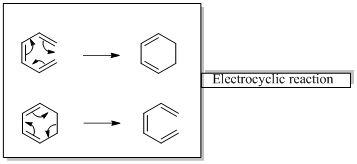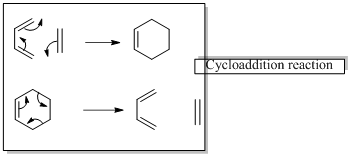
(a)
Interpretation:
The given reaction has to be identified as electro cyclic reaction, a cycloaddition reaction or a sigma tropic reaction.
Concept introduction:
Pericyclic reactions are “ any concerted reaction in which bonds are formed or broken in a cyclic transition state”. There is a single transition state from start to finish, in contrast to a stepwise reaction.
There are mainly three types of pericyclic reactions,
- 1) Electrocyclic reactions
- 2) Cycloaddition reactions
- 3) Sigmatropic reactions
In an electrocyclic reaction “one new sigma- bond is formed or broken.”

In a cycloaddition reaction “ two new sigma-bonds are formed or broken”

In a sigmatropic rearrangement reaction “ one new sigma-bond is formed as another breaks.”

(b)
Interpretation: The given reaction has to be identified as electro cyclic reaction, a cycloaddition reaction or a sigma tropic reaction.
Concept introduction:
Pericyclic reactions are “ any concerted reaction in which bonds are formed or broken in a cyclic transition state”. There is a single transition state from start to finish, in contrast to a stepwise reaction.
There are mainly three types of pericyclic reactions,
- 1) Electrocyclic reactions
- 2) Cycloaddition reactions
- 3) Sigmatropic reactions
In an electrocyclic reaction “one new sigma- bond is formed or broken.”

In a cycloaddition reaction “ two new sigma-bonds are formed or broken”

In a sigmatropic rearrangement reaction “ one new sigma-bond is formed as another breaks.”

(c)
Interpretation: The given reaction has to be identified as electro cyclic reaction, a cycloaddition reaction or a sigma tropic reaction.
Concept introduction:
Pericyclic reactions are “ any concerted reaction in which bonds are formed or broken in a cyclic transition state”. There is a single transition state from start to finish, in contrast to a stepwise reaction.
There are mainly three types of pericyclic reactions,
- 1) Electrocyclic reactions
- 2) Cycloaddition reactions
- 3) Sigmatropic reactions
In an electrocyclic reaction “one new sigma- bond is formed or broken.”

In a cycloaddition reaction “ two new sigma-bonds are formed or broken”

In a sigmatropic rearrangement reaction “ one new sigma-bond is formed as another breaks.”

(d)
Interpretation: The given reaction has to be identified as electro cyclic reaction, a cycloaddition reaction or a sigma tropic reaction.
Concept introduction:
Pericyclic reactions are “ any concerted reaction in which bonds are formed or broken in a cyclic transition state”. There is a single transition state from start to finish, in contrast to a stepwise reaction.
There are mainly three types of pericyclic reactions,
- 1) Electrocyclic reactions
- 2) Cycloaddition reactions
- 3) Sigmatropic reactions
In an electrocyclic reaction “one new sigma- bond is formed or broken.”

In a cycloaddition reaction “ two new sigma-bonds are formed or broken”

In a sigmatropic rearrangement reaction “ one new sigma-bond is formed as another breaks.”

Want to see the full answer?
Check out a sample textbook solution
Chapter 28 Solutions
Organic Chemistry; Modified MasteringChemistry with Pearson eText -- ValuePack Access Card; Study Guide and Student Solutions Manual for Organic Chemistry, Books a la Carte Edition (7th Edition)
- What will the enolate for this be using LDA, THF, and cold temperatures? What will it be using NaOEt at rt?arrow_forwardHelp me solve this problem.arrow_forwardDraw a mechanism for the following synthetic transformation including reagents and any isolable intermediates throughout the process. Please clearly indicate bond cleavage/formation using curly arrows. MeO2Carrow_forward
- CHEM 310 Quiz 8 Organic Chemistry II Due: Tuesday, April 25th, at 11:59 pm. This quiz is open textbook / open notes - but you must work alone. You cannot use the internet or the solutions manual for the book. Scan in your work and record an explanation of your mechanism. You may record this any way that you like. One way would be to start an individual Zoom meeting, start recording, "share your screen" and then talk through the problem. This will be converted to an .mp4 file that you can upload into Canvas using the "record/upload media" feature. Pyridine, benzoic acid and benzene are dissolved in ethyl acetate. Design and provide a plan / flow chart for separating and isolating each of these components. Pyridine and benzene are liquids at room temperature. Benzoic acid is a solid. You have ethyl acetate, 2M NaOH, 2M HCI and anhydrous MgSO4 available, as well as all the glassware and equipment that you used in the organic lab this year. Provide accurate acid/base reactions for any…arrow_forwardCan anyone help me solve this step by step. Thank you in advaarrow_forwardPlease draw the mechanism for this Friedel-crafts acylation reaction using arrowsarrow_forward

 Organic Chemistry: A Guided InquiryChemistryISBN:9780618974122Author:Andrei StraumanisPublisher:Cengage Learning
Organic Chemistry: A Guided InquiryChemistryISBN:9780618974122Author:Andrei StraumanisPublisher:Cengage Learning Organic ChemistryChemistryISBN:9781305580350Author:William H. Brown, Brent L. Iverson, Eric Anslyn, Christopher S. FootePublisher:Cengage Learning
Organic ChemistryChemistryISBN:9781305580350Author:William H. Brown, Brent L. Iverson, Eric Anslyn, Christopher S. FootePublisher:Cengage Learning


